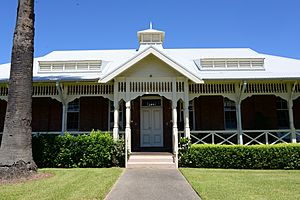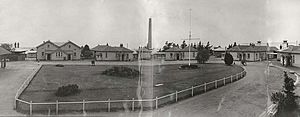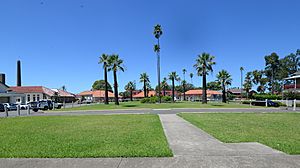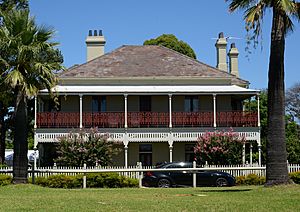Lidcombe Hospital Precinct facts for kids
Quick facts for kids Lidcombe Hospital Precinct |
|
|---|---|

One of the buildings in the former Lidcombe Hospital
|
|
| Location | Joseph Street, Lidcombe, Cumberland Council, New South Wales, Australia |
| Built | 1885– |
| Architect |
|
| Owner | Australand Industrial No. 18 Pty Limited; Sydney Olympic Park Authority |
| Official name: Lidcombe Hospital Precinct; Rookwood Asylum for the Aged and Infirm; Rookwood State Hospital and Asylum for Men; Lidcombe State Hospital & Home; Rookwood Boys Reformatory & Model Farm | |
| Type | State heritage (complex / group) |
| Designated | 24 February 2006 |
| Reference no. | 1744 |
| Type | Hospital |
| Category | Health Services |
| Builders | NSW Government |
| Lua error in Module:Location_map at line 420: attempt to index field 'wikibase' (a nil value). | |
The Lidcombe Hospital Precinct is a special historic site in Lidcombe, a suburb of Sydney. For over 100 years, it was a large hospital and home for the elderly. Today, its beautiful old buildings have been turned into modern apartments and houses.
This important place was designed by famous architects like James Barnet and Walter Liberty Vernon. Because of its long and interesting history, it is protected on the New South Wales State Heritage Register. This means it is recognized as a valuable part of Australia's story.
Contents
A Place with Many Lives: The History of the Site
The Lidcombe Hospital site has changed many times over the years. It has a rich history that shows how ideas about health and community have evolved.
Here are the main stages of its life:
- 1885–1892: It was first planned as a farm and school for boys who needed extra guidance.
- 1893–1913: It became the Rookwood Asylum, a home for elderly and unwell men who had nowhere else to go.
- 1914–1966: The name changed to Lidcombe State Hospital, and it grew into a major hospital.
- 1966–1995: It was known as Lidcombe Hospital and became a leading center for caring for the elderly, a field called geriatrics.
- 1998–2000: For the 2000 Summer Olympics in Sydney, the site was transformed into the Olympic Media Village, providing a temporary home for thousands of journalists from around the world.
After the hospital closed, some of the newer buildings were removed. Starting in 2006, the historic main buildings were carefully restored and converted into a new neighborhood called "Botanica," giving them a new purpose while preserving their history.
What the Site Looks Like
The Lidcombe Hospital site is like a small village with many historic buildings set in a beautiful, park-like landscape. It has wide lawns, old roads, and many different types of trees.
Key Buildings and Features
The site has a wonderful collection of buildings from different time periods. Some of the most important ones include:
- Barnet Buildings: Designed by James Barnet in the 1880s, these include the original dormitories (where people slept), a large dining hall, and the superintendent's house.
- Vernon Wards: Architect Walter Liberty Vernon designed nine unique hospital wards between 1893 and 1906. These buildings look a bit like large bungalows with wide verandahs to keep patients cool.
- Nurses' Homes: As the hospital grew, homes were built for the nurses who worked there.
- Recreation Hall and Chapel: A modern building designed by architect Ken Woolley in the 1960s for patients to relax and worship.
- The Village Green: A large, open grassy area at the heart of the site. It was a central meeting place for patients and staff.
- Boiler House and Chimney: Built in 1901, this tall chimney is a landmark that provided power and heat to the hospital.
Landscape and Nature
The grounds were designed to be a peaceful and healthy environment for patients. The site is famous for its beautiful avenues of trees, including:
- Hoop pines and phoenix palms along the main entrance.
- Tall tallowwood and brush box trees.
- Large Moreton Bay fig trees that provide lots of shade.
- Rows of Canary Island palms.
These planned gardens and open spaces were an important part of the hospital's design, based on the idea that nature helps people heal.
Why Is This Place So Important?
Lidcombe Hospital is "heritage-listed," which means it's officially recognized as a place of great importance to the history of New South Wales. It tells a fascinating story about health, architecture, and community life for over a century.
A Leader in Healthcare
For many years, Lidcombe Hospital was a pioneer in caring for the elderly. In the 1960s and 1970s, it became a leading teaching hospital for geriatric medicine, which is the special care of older people. Doctors and nurses at Lidcombe developed new methods for helping elderly patients stay active and healthy. The hospital's growth and eventual closure also show how government ideas about healthcare have changed over time.
Amazing Architecture
The site is like an outdoor museum of Australian architecture. It has an amazing collection of buildings from different eras, designed by some of the state's most important architects.
The design of the hospital followed the ideas of Florence Nightingale, a famous nurse who believed that fresh air, sunlight, and beautiful gardens were essential for healing. The wards designed by Walter Liberty Vernon are special because they used an Australian "bungalow" style with wide verandahs. This was a new way of designing public buildings to suit the Australian climate, making them different from hospitals in England.
A Place for the Community
Lidcombe Hospital was a major employer and an important part of the local community for generations. Many local families have connections to the site, either as former staff, patients, or visitors. It is still valued by community groups who work to protect its history and share its story.
A Window into the Past
The layout of the buildings, the old roads, and even things buried underground can teach us about how people lived and were cared for in the past. Archaeologists are interested in the site because it might hold clues about daily life in the asylum and hospital. It was also the location of one of Australia's first large-scale septic tank systems, a major step forward in public health.
See also




